Blix Sol X Review | The Cruiser/Commuter of the Future?
This relaxed beach cruiser boasts a powerful 750W motor, a responsive and natural ride, electronic shifting, and a cool, contemporary design.
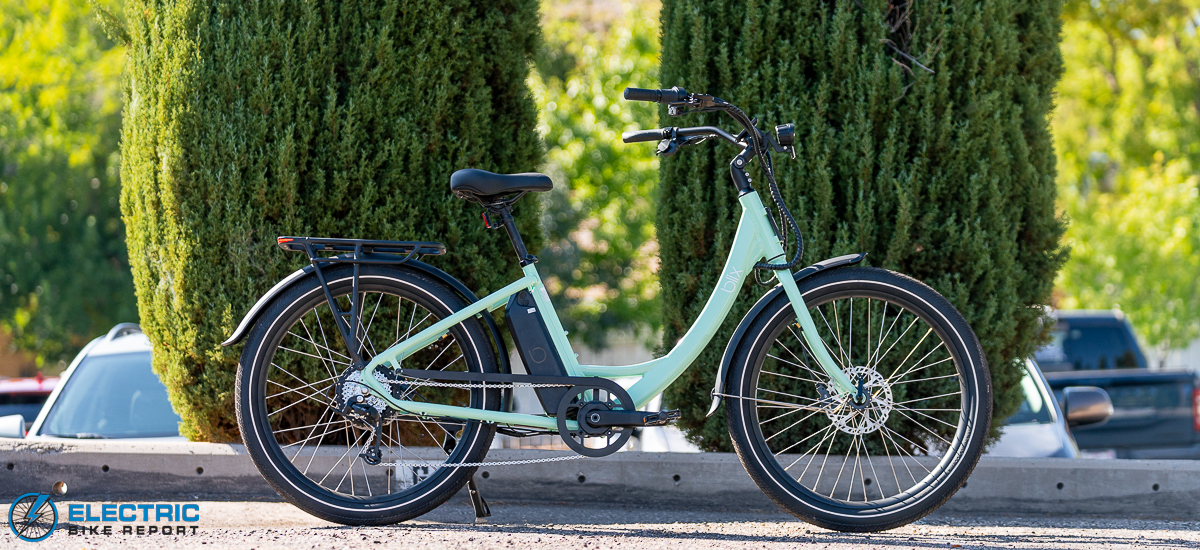
Cruiser-style e-bikes are known far and wide for their comfort, with upright riding positions and a relaxed, leisurely feel. They’re often simple, feature-light, and uncomplicated, which makes them easy to operate—but this also means they may lack some functional elements.
Additionally, beach cruisers don’t usually have a reputation for being high-tech or high-performance, but the Blix Sol X isn’t your average cruiser.
Like the Vika X we reviewed a short time prior to the Sol X, this bike is loaded with cool technology features that are uncommon for its style and price point. The Sol has an electronic shifting system. It also pairs with the Blix Connect app for ride data and customization, and it offers an Auto pedal assist setting with optional automatic shifting.
The Sol X also offers a comfortable ride with better-than-expected handling and a responsive feel. It pedals similarly to an analog bike thanks to its torque sensor, and its relatively light construction keeps it feeling lively and highly maneuverable on the road or path.
On top of that, it includes a variety of commuter-friendly features to enhance safety and functionality. The bike has integrated turn signals and lights (including a high- and low-beam LED headlight), a cargo rack, and fenders.
The Sol X even breaks from the norm in its appearance; where many electric cruisers look like they’re fresh out of the 1950s, Blix opted for a much more contemporary vibe with black trim and a selection of cool, trendy colors.
Intrigued yet? Keep reading our full review of the Sol X below to find out how it fared in our series of standardized Speed, Brake, Range, and Hill tests!
Class 3 (pedal assist to 28 mph)
 Pros
Pros- The Sol X has an analog-like ride thanks to its torque sensor, but its 750W hub motor can be speedy and powerful when needed—just pedal harder!
- The bike has relaxed but uncommonly nimble handling for a cruiser because of its weight distribution, 26×2.4” tires, and light, minimalistic frame.
- It’s packed with cool features, including electronic shifting, an auto-assist setting, turn signals, a high and low-beam headlight, etc.
- We cover the specifics in our Range Test section below, but the Sol X performed extremely well with its 614.4-Wh battery!
- A 17” standover height makes hopping on and off the bike easy for riders with a limited range of motion.
- As with most cruisers, the Sol has a relaxed and comfortable ride. Users can tailor the bike’s fit thanks to an adjustable stem.
- With lights, fenders, and a cargo rack with 59.5 lbs of capacity, the Sol X is equipped for commuting and errand running. A front rack or basket can also be added.
- Visually, the Sol X has a more contemporary design than the classic vibe of most cruisers. It’s also available in four unique color options.
- The Blix Connect app allows users to track ride data, change speeds/Classes, adjust settings, and get over-the-air (OTA) updates.
 Cons
Cons- Changing the bike’s speed seemed to have unintended consequences, like removing the throttle speed limit. Hopefully, an OTA update will solve the issue.
- The bike’s battery charge indicator was inconsistent in its reading, and the pedal assist system shut down at 11%. We’d prefer a more user-friendly system.
- Battery:614.4Wh (48V)
- Display: Color LCD
- Motor: Rear Hub, Geared, 750W, 70Nm Torque
- Headlight:Integrated, Low-beam 70 lux, High-beam 120 lux
- Taillights:Integrated, Turn Signal, Brake Light
- Pedal Assist: 3 Levels + Auto Function, Torque Sensor
- Claimed Range: Up to 70 Miles
- Throttle:Yes
- App:Blix Connect
- UL Certification:UL 2849 Certified
- Claimed weight: 62 lbs
- Tested Weight: 60.8 lbs
- Rider height range: 5’1” – 6’2”
- Total payload capacity: 400 lbs, 318 lbs max rider weight
- Brakes: Hydraulic Disc, 180mm Rotors
- Fenders: Included, Plastic, PVC
- Fork: Steel
- Frame: Aluminum Alloy
- Drivetrain:8-speed, 46T chainring, 13-32T cassette, electronic shifting
- Grips: Ergonomic, Rubber
- Saddle: Comfort Padded
- Handlebar:660mm Wide, 25.4mm Clamp
- Kickstand: Included
- Pedals: Platform
- Tires: 26” x 2.4”, Puncture Resistant, Reflective Strip
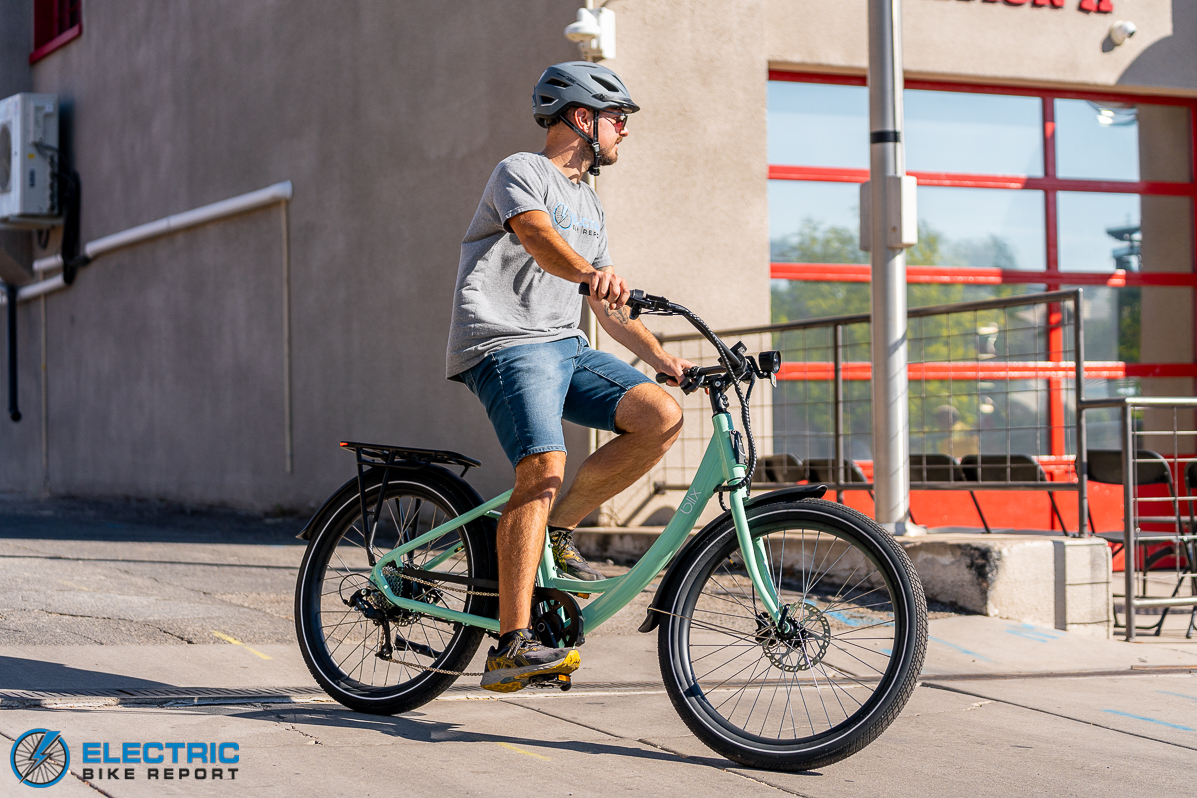
We liked the Sol X’s stable ride and agile feel. It’s as cool and comfortable as it looks!
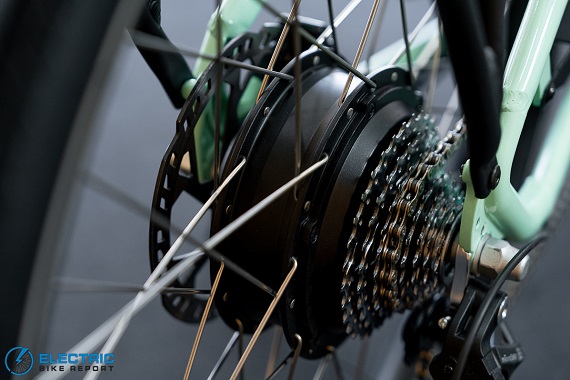
The 750W motor has plenty of power for hills and speed when it’s wanted, but overall, the ride feels natural and responsive.

The bike’s handlebar-mounted control panel includes shift levers (paddles?) to change gears.
Blix Sol X Review: Speed Test

I tested the Sol X’s throttle and pedal assist system (PAS) in our Speed Test by riding on paved shared-use paths and recording my average speeds in each of the bike’s three PAS settings. Technically, there’s a fourth assist level—the Auto mode mentioned in the intro—but I will discuss that setting in the Ride Quality section later in the review.
As it ships, the Sol X is a Class 2 e-bike with throttle and pedal assist up to 20 mph. I tested it in this mode as well as in its Class 3 settings (accessible through the Blix Connect app), where pedal assist can reach 28 mph. My average and maximum speeds from both tests are shown in the graph above.
Ideally, the data points from this test should form an angled line reflecting consistent increases in speed between each pedal assist setting. In its Class 2 mode test, the Sol X’s data showed exactly this sort of linear pattern, which also coincided with how it felt to ride; the same level of effort resulted in higher speeds as I stepped through its PAS levels.
In the Class 3 mode test, my speeds were nearly identical to my Class 2 test results, with the exception of Turbo mode. There, I was able to exceed 20 mph with the same moderate level of effort applied in Eco and Tour modes, but I reached the bike’s 28 mph maximum speed with more effort.
I appreciated that the Sol X maintained a natural, analog-like feel throughout this test, but I hoped for more differentiation in the Class 3 portion of the test. With higher speeds across the board instead of just in Turbo mode, the bike’s programming would have reflected more intuitive differences in speed between settings.
As it is, however, I liked that it was possible to reach Class 3 speeds relatively quickly and easily when I wanted to ride fast. The Sol’s current programming encourages moderate speeds, which feel appropriate for its style, and also helps conserve battery charge to extend range, but we’ll address that topic in the next section of this review.
Eco mode felt best for instances when maximizing range is key, but it is also suitable for those who prefer to ride slower or who enjoy a workout. Tour mode seemed ideal for general riding with its balance between motor efficiency and speed. Finally, Turbo mode proved to be best suited for hills and reaching Class 3 speeds above 20 miles per hour.
When testing the bike’s throttle, I appreciated its initially gradual acceleration that picked up more swiftly over time. This gave the bike a controlled but also fun feel, which is a great summary of how the Sol X felt and performed in this test overall. Generally, it did a solid job, even if there might be a little room for improvement in the bike’s Class 3 settings.

Thanks to its 750W motor, the Sol X performed extremely well in our Hill Test.

The 8-speed Microshift drivetrain features a cable-actuated derailleur operated electronically by a module on the handlebar.

The bike’s 614.4-Wh battery slots in place behind its seat tube and keeps its weight balanced.
Blix Sol X Review: Range Test

We tested the Sol X’s range in a series of two tests, as explained in the graphic above. The bike did an excellent job with results that look great on their own—but the bike looks even better when compared to the cruiser e-bike category averages from our testing.
As a caveat, our results were based on the Sol X’s Class 2 settings. Those riding in Class 3 mode at speeds above 20 miles per hour will likely burn through battery charge faster and should expect less range.
At the time of writing, the Sol X has the longest range among all of the beach cruiser e-bikes we’ve tested! Those bikes averaged 26.4 and 54 miles in their range tests. This gives the Sol X an 11.7-mile lead in its Turbo mode test and a 31.7-mile lead in its Eco mode test.
Two main factors seemed to play into the bike’s success. First, its 614.4-Wh battery is larger than average for the category; 584-Wh is currently the middle of the road based on the other bikes we’ve tested.
Second, most of the other cruisers we tested had cadence sensors instead of torque sensors. These bikes are often less efficient, as their motors put out a constant flow of power, while the Sol X’s motor output can fluctuate. This allows it to stretch out its charge over a greater number of miles.
The bike’s efficiency is supported by the difference between our estimated and real-world results for the Turbo mode test. Based on the Sol X’s 614-Wh battery and 750W motor, we expected our test would last roughly 50 minutes and yield between 15 and 20 miles. Our testing resulted in nearly two additional hours of ride time and roughly double the expected mileage.
During our testing, we noted one important aspect of the bike that potential buyers should be aware of. The Sol X’s pedal assist system stopped functioning at 11% instead of somewhere closer to 0% (where most users would likely expect).
Additionally, the battery readout could be inconsistent, which made it difficult to estimate its remaining range. We’d prefer a more reliable charge reading and slightly more intuitive programming for when the bike reaches a low charge level.
Those minor points of critique aside, we expect that most riders should get at least a couple of round-trip commutes in before needing to recharge (depending on distance, of course). Riders using this bike for shorter leisure trips should be able to enjoy many rides before needing to plug in!
Blix Sol X Review: Hill Test
We tested the Sol X’s hill climbing ability using the process explained above and found it more capable than many similar bikes of its style! The Sol X conquered Hell Hole Trail in both tests, which isn’t something we can say about all beach cruisers we’ve tested.
Other e-bikes in the cruiser e-bike category averaged 2:04 in the throttle test, making the Sol X 45 seconds faster than average. In the pedal portion of the test, the cruiser average (at the time of writing) is 1:42, so the Sol was 10 seconds faster than the average there.
These results weren’t that surprising for one simple reason: the Sol X’s powerful 750W motor. Most of the similar bikes we’ve tested were equipped with less powerful 500W or even 350W motors that were generally less capable on hills.
It is fairly uncommon for our pedal test results to be slower than throttle test times. In the case of the Sol X, we attribute this to the bike’s torque sensor and its programming, which favors a more natural feel. Where the torque sensor was an advantage in the Range Test section above, the resulting fluctuations in power output were a slight downside here.
While Justin performed our formal Hill Test with the Sol X, I tested it at our secondary location (called Pilot Hill) to understand its capabilities. The bike was not a powerhouse—it felt controlled and steady—but it made the job of climbing both possible and infinitely more enjoyable.
Based on our formal test and my personal experience, I can confidently say that the riders can rely on the Sol X’s throttle for an effort-free approach to hills. Those who choose to pedal uphill won’t have to work very hard, as the bike’s motor is more than powerful enough (and its torque sensor is responsive enough) to get the job done.

Whether riding to work or just going out for a spin, the Sol X encouraged a relaxed and easygoing approach.
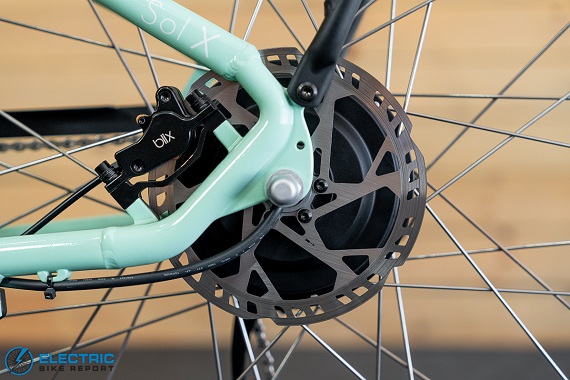
Custom hydraulic disc brakes with thicker-than-average rotors performed well in our testing.
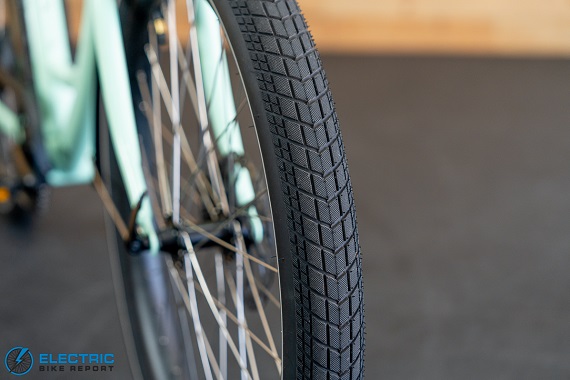
The bike’s 26×2.4” tires offered stability and cushion with an all-weather tread pattern.
Blix Sol X Review: Brake Test
We used the method above to measure the Sol X’s stopping ability. Its average distance after three tests was 19’10”, which is over two feet better than the cruiser category average of 21’11”.
A handful of factors influence braking performance, including a bike’s overall weight, brake system/specs, weight distribution, and tire size. The Sol X’s custom Blix-branded hydraulic disc brake system, with 2-piston calipers and 180-mm rotors, seemed to be the biggest distinguishing factor when compared to similar cruisers we tested.
We found that the system felt and performed extremely well; the brake levers themselves felt somewhat soft, but the system had great bite and good modulation.
Additionally, it uses thicker-than-average rotors; most hydraulic systems we’ve tested used 1.8-millimeter rotors, but the Sol X had 2.3-millimeter rotors. This makes the Blix system better at dispersing heat.
Finally, the placement of the Sol X’s battery behind its seat tube may have also played a part; when other factors are more or less equal, we have often seen shorter-than-average stopping distances on bikes with a similar design.
In my personal testing with the bike, I noted that it felt stable when braking and didn’t deviate much from its line of travel as it slowed. Between its feel and performance when compared to similar cruiser-style e-bikes, we give it an enthusiastic two thumbs up.
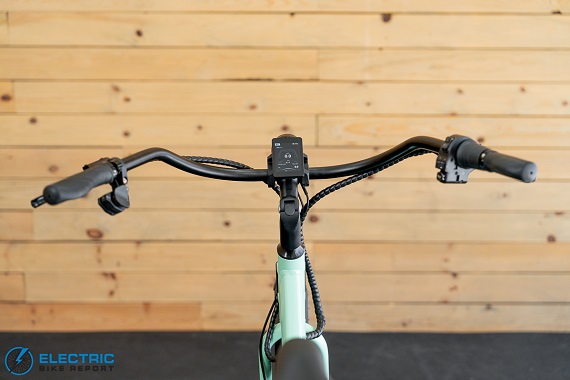
Wide, swept-back handlebars give the ride a casual and ergonomic feel.

The Sol X has a rigid fork for predictable handling and efficient braking.
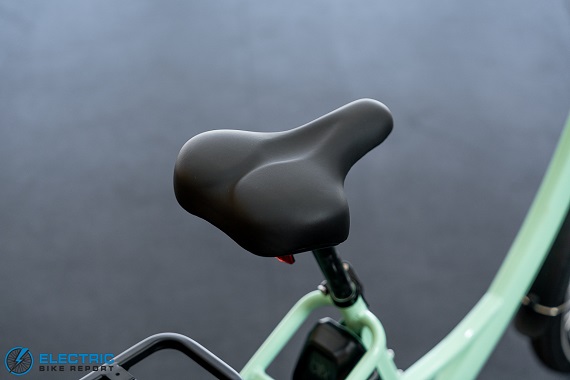
A comfortable, cushy saddle made long rides enjoyable. It also helped to absorb bumps and smooth out the ride.

The right handlebar features a module for the lights, turn signals, and horn next to a half-twist throttle.
Blix Sol X Review: Ride Quality
The previous test sections have measured objective performance with data, but the subject of ride quality tends to be much more subjective. In this section, we will examine many of the elements and aspects of the Sol X that contribute to how it feels to ride.
As a cruiser-style e-bike, we expected it to exhibit many of the defining characteristics of this category—primarily an extremely comfortable and relaxed feel. With a wide, well-cushioned saddle, an upright seating position, and curved handlebars with ergonomic grips, the Sol X met our expectations with its enjoyable, accommodating feel.
The bike is available in a single frame size intended for riders between 5’1” and 6’2”. It has an 8” saddle height adjustment, and its stem is adjustable, allowing riders to change its angle and alter the bike’s handlebar height and reach.
At 5’11”, I found its sizing to be appropriate and comfortable. I was able to raise the saddle for proper and efficient leg extension, and I set the handlebars to a comfortable (still relatively low) height.
I referenced the bike’s nimble handling in the intro; with most of its weight below or behind the saddle, its steering responded extremely quickly. The Sol X is also stable while riding, thanks to its long wheelbase and stretched-out geometry.
The bike’s fork is rigid, so it has no suspension outside of its saddle and tires. When riding, bumps felt softened by these features but still somewhat noticeable. Rigid forks are common on beach cruisers, so this was not unexpected, and this feature also contributes to the Sol X’s handling.
While I have discussed the bike’s natural feel and adaptive, responsive motor output previously, these elements are central to the Sol X’s experience. I appreciated the fact that, while the bike’s uncommonly powerful motor can make short work of hills and deliver fast speeds, it never felt overpowered; it was never obvious that I was riding an e-bike.
The bike’s high-tech electronic shifting was another core element of its ride. In addition to quick, responsive gear changes (and a cool beep), the system also offers an automatic shifting feature that was in beta-testing mode during our review.
When activated, this feature only functions when using the Auto pedal assist setting; it automatically changes gears to match a pre-selected measure of rider power (in watts) and a target cadence. Both of these targets are set using the Blix Connect app.
In addition to allowing users to change the bike’s speed settings, engage and tune the auto-shifting feature, and download firmware updates, the Blix Connect app also allows riders to access useful ride data. Much of this data is identical to what is shown on the bike’s display, but it also includes a power meter and an estimated remaining range.
It’s important to note that while we found the Sol’s tech package to be a boon to its ride quality, the system was not perfect. The automatic shifting feature generally worked well, though it could feel somewhat jarring because it shifted unpredictably (especially on hills).
Additionally, we found that changing the bike’s speeds could disrupt its programming. In some instances, the motor output changed to require much more effort to reach Class 3 speeds, while at other times, the throttle and pedal assist system exceeded the limits I set within the app. Considering that the app allows firmware updates, we hope these issues can be corrected in the future.
The Sol’s electronic shifting system and the control module on its right handlebar (which manages its lights, turn signals, and electronic horn) added a small layer of complexity, but overall, I found this bike very easy to use and well worth the learning curve.
I especially appreciated the bike’s three standard PAS settings; many e-bikes include five or more power levels that can feel like too many. I’m certain that, whether using the automatic shifting feature or not, many riders will appreciate the ease of the Auto assist mode, which makes it easy to simply hop on and pedal!
Overall, the Sol X excels in the area of ride quality, with comfort, responsiveness, and handling being some of its defining features. The bike is not without its quirks, though we found its technology to be unique and its ride extremely enjoyable and fun.
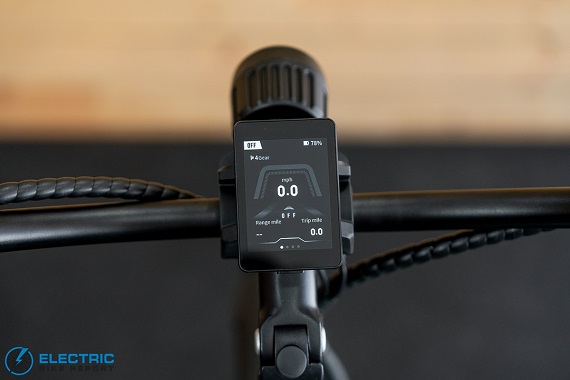
The bike’s custom color display presents data in an organized and easy-to-read manner.
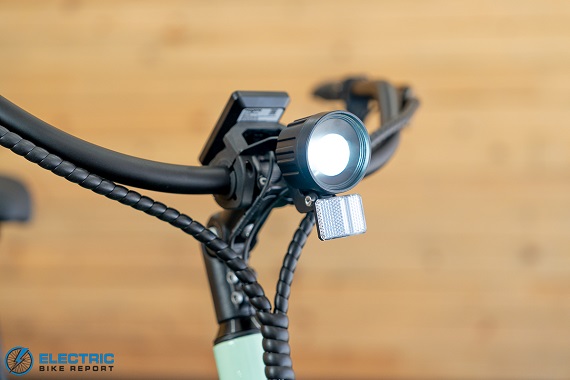
A large integrated LED headlight features both a high and a low beam.

Soft, ergonomic rubber grips felt comfortable and grippy.

The bike’s tail light and turn signals are integrated into its rear cargo rack.
Blix Sol X Review: Summary / Where to Buy
The Sol X is a cool and unique take on a cruiser-style e-bike; it stands out in terms of looks, functional technology—and, perhaps most importantly, performance. It also simply feels great to ride thanks to its simplicity, comfortable contact points, and overall build quality.
As long-time fans of Blix’s e-bikes, we appreciate the brand’s approach. Every model we’ve tested—including the Sol X—has given us the sense of being intentionally crafted with user-friendliness and practicality in mind. With the new technology package that will eventually make its way to each of the company’s models, this cruiser/commuter hybrid simply rocks!
The Sol X proved to have good overall programming in our Speed Test, great stopping power in our Brake Test, and respectable climbing power in our Hill Test. Our Range Test is where it truly shined, however, with the ability to cover a seriously impressive distance on a single charge.
Of course, it isn’t perfect; we encourage Blix to implement a more reliable battery charge readout in the future. We also hope to see a firmware update to address the speed limitation bugs we encountered when changing settings. Our contact advised us that the Auto-shift feature will be continuously improved, and we can’t wait to see where it goes!
We highly recommend the Sol X to anyone looking for a comfortable, nimble, and high-tech cruiser. With its included commuter-friendly features, it is extremely well-suited for daily use when riding to work or school. It doesn’t have to be a workhorse, though; we think it’s a perfect choice for leisure rides in the evenings after work, too.
Happy Riding! Make sure to let us know if you have any questions or if you think we left anything out in our comments section in this review of the Blix Sol n.



Hey guys, I really enjoy your site and videos. You definitely own the electric bike space on the Web.
My question is, I have the Aventon Level 2. It’s a great bike, as you know. However, it’s rough going over bumps on the road. I have installed a suspension seat post, (though perhaps it’s not adjusted optimally) which helps, but I’m wondering if you could recommended some bikes in the $3,500 range (or less) that can be ridden on some rough terrain smoothly while also serving well as a commuter bike. Any type of bike (eMBT, gravel, etc.) that does both well is fine. Ideally I’m looking for a class-3 bike with a torque senser and a throttle.
Thanks
Hi Ro, we responded in last week’s episode of our weekly show on YouTube! We recommended the Euphree Stellar Falcon, the Mokwheel Obsidian, and the Specialized Turbo Tero X 4.0, which are all in your price range.